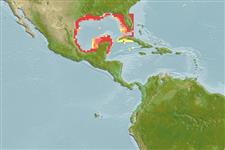>
Eupercaria/misc (Various families in series Eupercaria) >
Sciaenidae (Drums or croakers)
Etymology: Cynoscion: Greek, kyon = dog + Greek, odous = teeth + Greek, skion, skiaina = barbel, red mullet (Ref. 45335).
More on author: Ginsburg.
Environment: milieu / climate zone / depth range / distribution range
Ecologia
marinhas; estuarina demersal. Subtropical; 30°N - 18°N, 98°W - 80°W
Western Atlantic: Florida, USA and Gulf of Mexico to Bay of Campeche, Mexico.
Length at first maturity / Tamanho / Peso / Idade
Maturity: Lm 14.0 range ? - ? cm
Max length : 63.5 cm TL macho/indeterminado; (Ref. 40637); common length : 35.0 cm TL macho/indeterminado; (Ref. 3702); peso máx. Publicado: 2.8 kg (Ref. 40637); Idade máx. registada: 5 anos (Ref. 58079)
Espinhos dorsais (total): 9 - 11; Raios dorsais moles (total): 25-29; Espinhos anais 2; Raios anais moles: 10 - 12. Colour uniform silvery grey above, without conspicuous spots, silvery below. Pelvic and anal fins pale to yellowish. A faint dark area at bases and axial of pectoral fins. Inside opercle darkish, often visible externally. Mouth large, oblique, lower jaw slightly projecting. Upper jaw with a pair of large canine-like teeth at tip. Lower jaw with a row of widely spaced larger inner-row teeth, gradually increasing in size posteriorly. Chin without barbel or pore, snout with 2 marginal pores. Gas bladder with a pair of horn-like anterior appendages. Soft portion of dorsal fin with few small scales rows at base between soft fin rays (Ref 51721).
Occurs usually over sandy bottoms in shallow coastal waters, being relatively abundant in the surf zone. During summer months the fish move to their nursery and feeding grounds in river estuaries.
Life cycle and mating behavior
Maturidade | Reprodução | Desova | Ovos | Fecundidade | Larvas
Robins, C.R. and G.C. Ray, 1986. A field guide to Atlantic coast fishes of North America. Houghton Mifflin Company, Boston, U.S.A. 354 p. (Ref. 7251)
Categoria na Lista Vermelha da IUCN (Ref. 130435)
Ameaça para o homem
Harmless
Utilização humana
Pescarias: espécies comerciais
Mais informação
ColaboradoresFotografiasStamps, Coins Misc.SonsCiguateraVelocidadeTipo de nataçãoÁrea branquialOutras referênciasCérebrosVisão
Ferramentas
Relatórios especiais
Descarregue XML
Fontes da internet
Estimates based on models
Preferred temperature (Ref.
123201): 23.4 - 27.1, mean 24.8 °C (based on 190 cells).
Phylogenetic diversity index (Ref.
82804): PD
50 = 0.5000 [Uniqueness, from 0.5 = low to 2.0 = high].
Bayesian length-weight: a=0.01023 (0.00609 - 0.01719), b=3.06 (2.92 - 3.20), in cm total length, based on LWR estimates for this species & Genus-body shape (Ref.
93245).
Nível Trófico (Ref.
69278): 4.2 ±0.3 se; based on diet studies.
Generation time: 3.5 ( na - na) years. Estimated as median ln(3)/K based on 1
growth studies.
Resiliência (Ref.
120179): Médio, tempo mínimo de duplicação da população 1,4 - 4,4 anos (Preliminary K or Fecundity.).
Fishing Vulnerability (Ref.
59153): Moderate vulnerability (36 of 100).
Nutrients (Ref.
124155): Calcium = 65.5 [35.9, 126.6] mg/100g; Iron = 1.01 [0.53, 1.76] mg/100g; Protein = 19.1 [17.6, 20.8] %; Omega3 = 0.372 [0.217, 0.586] g/100g; Selenium = 26.9 [14.2, 52.0] μg/100g; VitaminA = 16 [5, 55] μg/100g; Zinc = 0.64 [0.46, 0.93] mg/100g (wet weight); based on
nutrient studies.
